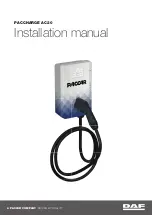
KC-P30 x-series
Functions
Configuration manual V4.14
30
© KEBA
●
Assignment via UDP connection
●
Readout of an external meter using Modbus TCP
If a current limit is specified via several different types, then the lowest preset
value is used for the currently valid current limit.
5.1.4
Phase-related load management
Phase-related load management is used for a charging network with charg-
ing stations with a 3-phase connection.
The charging station verifies how many phases a vehicle is charging and de-
tects whether the vehicle is one that charges with 1, 2 or 3 phases.
This information is ultimately used to regulate the uniform charging current
distribution to the 3 phases.
5.2
RFID authorization
Certain device variants are equipped with an RFID reader, which enables
the authorization of a charging process with RFID cards in accordance with
ISO 14443 and ISO 15693. The RFID authorization only allows a charging
session to be started if an identification takes place by means of an RFID
card. The authorization function is enabled and disabled in the web interface
of the master.
In the case of a local charging network without a higher-level OCPP back-
end, all RFID cards must be taught in at the master. Up to 1000 RFID cards
can be stored. After teaching in, the permitted RFID cards are stored at the
master and are managed by it in the charging network. It is not possible to
teach in RFID cards at a client charging station.
When connecting to an external OCPP backend, all RFID cards must be
taught in at the OCPP backend. Any number of RFID cards can be stored. It
is not possible to teach in the RFID cards directly at a charging station.
The first 1000 RFID cards are relayed from the OCPP backend to the mas-
ter, where they are stored locally. This enables charging sessions to be au-
thorized even if the connection fails temporarily. In case of a connection fail-
ure, authorization requests, depending on the authorization mode, are com-
pared to the locally stored RFID cards.
5.2.1
Authorization modes
The authorization modes described below are available in the web interface
if the authorization function has been activated.
Online authorization mode
This defines which storage location an authorization request is to be com-
pared to.












































